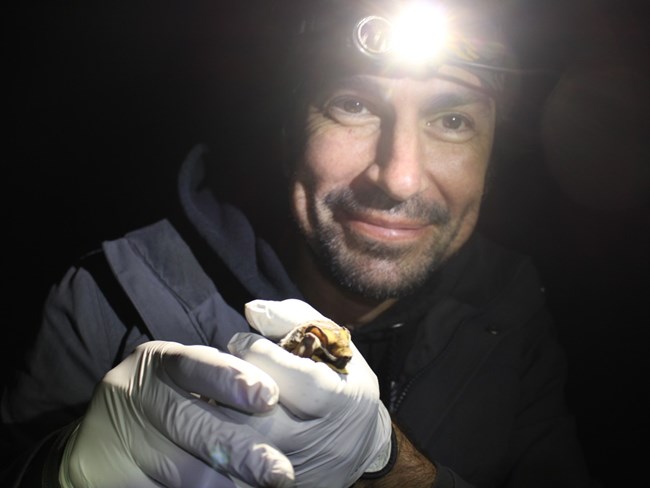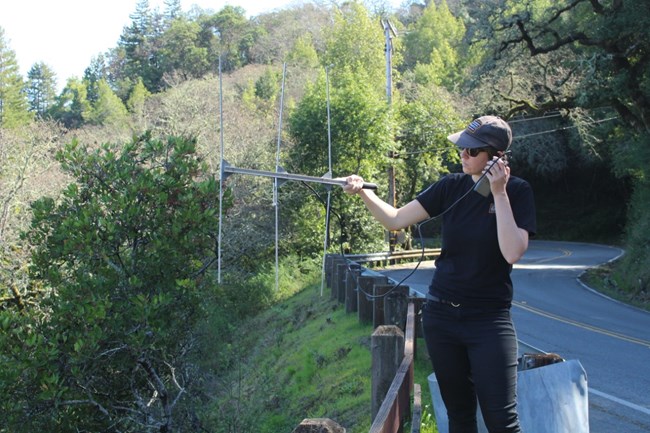Last updated: November 4, 2020
Article
Mist Netting, Radio Telemetry, and Acoustic Monitoring: What We’re Learning About Bats in Marin

Golden Gate National Parks Conservancy
October 2020 - In 2016, researchers conducting the first One Tam ecological health assessment identified understanding the bat species of Mount Tam as an important research goal. Biologists and park managers alike had basic questions about these animals that remained unanswered, including which bat species are present and how they use habitats in Marin. In 2017, One Tam teamed up with ongoing U.S. Geological Survey (USGS) bat research efforts to close those information gaps.
Three years later, researchers are on their way to answering these critical questions. Researchers have confirmed the presence of 13 different bat species on Mount Tam. The study has since expanded to include more of the county’s other parks and open spaces, and now includes roosting site surveys.
Through monitoring data, biologists are able to better understand bat populations in Marin County and prepare to protect them from threats like white nose syndrome and changes in habitat due to climate change and human development.

Wendy Baker / Golden Gate National Parks Conservancy
Winter Mist Netting, Radio Telemetry, and Acoustic Monitoring
Although the coronavirus pandemic prevented bat monitoring teams from conducting summer telemetry as normal, research teams still made significant progress during the winter 2019/2020 monitoring season. Park and partner researchers captured 26 bats of four different species over the course of seven nights in Cascade Canyon and Marin Municipal Water District lands. Bats were fitted with tiny radio transmitters and released. They located and described 13 different bat roosts, and even found evidence of a female hoary bat (Lasiurus cinereus) wintering ground! Hoary bats are long distance migrators that roost by themselves in the leaves of trees, making them notoriously difficult to study. Female hoary bat wintering grounds have not been previously documented, and prior to this finding researchers had a bias towards capturing males in Marin County. This finding adds to our knowledge of hoary bat movement ecology, and may lead to future research opportunities to learn more about winter ecology of this species, which may be declining in parts of its range.
This year, researchers also conducted acoustic monitoring at 37 sites on partner lands across Marin County, with 148 total nights of recording bat echo location calls. Acoustic data will contribute to a local and continent level (NABat) understanding of trends in bat species and habitat usage.
This work is helping researchers to learn which habitats and tree species bats are selecting to roost in, and providing more information on bat movement patterns and population behaviors. Preliminary observations indicate that Marin’s bats make use of a diverse assortment of tree types—from towering giants to fallen snags, as well as human structures.
These findings underscore how parks provide critical habitat and foraging areas for bats. But because Marin is a patchwork of parks and private lands, it’s not surprising that radio telemetry tracking signals sometimes lead researchers to Marin neighborhoods, including one resident's backyard bat box! Hopefully this research will help biologists and park managers work together to manage bat populations that move between park habitats and more developed urban areas.
For more information
- Contact Assistant Biological Monitor Katie Smith
- Learn more about bat conservation in the San Francisco Bay Area.
- Bats are very important ecologically, but are often maligned and misunderstood. Learn more about the myths and misconceptions surrounding bats with this engaging and informative video created for the San Francisco Public Library by Parks Conservancy wildlife technician, Katie Smith.
- One Tam Bat Monitoring webpage
- USGS Bat Research in California webpage
- Pacific Coast Science and Learning Center Bats webpage
